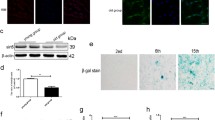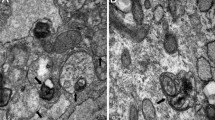Abstract
Many studies have demonstrated that SIRT1, an NAD+-dependent deacetylase, reduces apoptosis in several different cells. However, the role of SIRT1 in apoptosis of disc nucleus pulposus (NP) cells remains unclear. The present study was performed to determine whether degenerative human NP would express SIRT1, and to investigate the role of SIRT1 in NP cells apoptosis. The expression of SIRT1 in disc NP of patients (>55 years) with lumbar disc degenerative disease (DDD) and the disc NP of patients (<25 years) with lumbar vertebra fracture (LVF) was assessed by immunohistochemistry, reverse transcription polymerase chain reaction, and Western blot analysis. The results showed that SIRT1 mRNA and protein levels were greater in LVF disc NP than those in DDD disc NP. Degenerative human NP cells were treated in culture with activator or inhibitor of SIRT1, resveratrol or nicotinamide, or SIRT1 small interfering RNA (siRNA), and cell apoptosis was quantified via flow cytometry. The rate of apoptosis was far fewer in resveratrol-treated NP cells than in SIRT1 siRNA-transfected or nicotinamide-treated NP cells. After SIRT1 siRNA was transfected, NP cells decreased phosphorylation of Akt, while resveratrol phosphorylated Akt. Treatment with LY294002 or Akt siRNA increased the rate of apoptosis. Our results suggested that SIRT1 plays a critical role in survival of degenerative human NP cells through the Akt anti-apoptotic signaling pathway.






Similar content being viewed by others
References
Alcendor RR, Gao S, Zhai P, Zablocki D, Holle E, Yu X (2007) Sirt1 regulates aging and resistance to oxidative stress in the heart. Circ Res 100:1512–1521
Anastasiou D, Krek W (2006) SIRT1: linking adaptive cellular responses to aging-associated changes in organismal physiology. Physiology 21:404–410
Antoniou J, Steffen T, Nelson F, Winterbottom N, Hollander AP, Poole RA (1996) The human lumbar intervertebral disc: evidence for changes in the biosynthesis and denaturation of the extracellular matrix with growth, maturation, ageing, and degeneration. J Clin Invest 98:996–1003
Araki T, Sasaki Y, Milbrandt J (2004) Increased nuclear NAD biosynthesis and SIRT1 activation prevent axonal degeneration. Science 305:1010–1013
Bibby SR, Jones DA, Lee RB, Yu J, Urban JPG (2001) The pathophysiology of the intervertebral disc. Joint Bone Spine 68:537–542
Buckwalter JA (1995) Aging and degeneration of the human intervertebral disc. Spine 20:1307–1314
Cheng CC, Uchiyama Y, Hiyama A, Gajghate S, Shapiro IM, Risbud MV (2009) PI3K/AKT regulates aggrecan gene expression by modulating Sox9 expression and activity in nucleus pulposus cells of the intervertebral disc. J Cell Physiol 221:668–676
Cohen HY, Miller C, Bitterman KJ, Wall NR, Hekking B, Kessler B (2004) Calorie restriction promotes mammalian cell survival by inducing the SIRT1 deacetylase. Science 305:390–392
Crean JK, Roberts S, Jaffray DC, Eisenstein SM, Duance VC (1997) Matrix metalloproteinases in the human intervertebral disc: role in disc degeneration and scoliosis. Spine 22:2877–2884
Csaki C, Keshishzadeh N, Fischer K, Shakibaei M (2008) Regulation of inflammation signalling by resveratrol in human chondrocytes in vitro. Biochem Pharmacol 75:677–687
Cs-Szabo G, Ragasa-San Juan D, Turumella V, Masuda K, Thonar EJ, An HS (2002) Changes in mRNA and protein levels of proteoglycans of the anulus fibrosus and nucleus pulposus during intervertebral disc degeneration. Spine 27:2212–2219
Dave M, Attur M, Palmer G, Al-Mussawir HE, Kennish L, Patel J, Abramson SB (2008) The antioxidant resveratrol protects against chondrocyte apoptosis via effects on mitochondrial polarization and ATP production. Arthritis Rheum 58:2786–2797
Dvir-Ginzberg M, Gagarina V, Lee EJ, Hall DJ (2008) Regulation of cartilage-specific gene expression in human chondrocytes by SirT1 and nicotinamide phosphoribisyltransferase. J Biol Chem 283:36300–36310
Furukawa A, Tada-Oikawa S, Kawanishi S, Oikawa S (2007) H2O2 accelerates cellular senescence by accumulation of acetylated p53 via decrease in the function of SIRT1 by NAD+ depletion. Cell Physiol Biochem 20:45–54
Gagarina V, Gabay O, Dvir-Ginzberg M, Lee EJ, Brady JK, Quon MJ (2010) SirT1 enhances survival of human osteoarthritic chondrocytes by repressing protein tyrosine phosphatase 1B and activating the insulin-like growth factor receptor pathway. Arthritis Rheum 62:1383–1392
Glozak MA, Seto E (2007) Histone deacetylases and cancer. Oncogene 26:5420–5432
Gruber HE, Hanley EN Jr (1998) Analysis of aging and degeneration of the human intervertebral disc. Comparison of surgical specimens with normal controls. Spine 23:751–757
Gruber HE, Hanley EN Jr (2003) Biologic strategies for the therapy of intervertebral disc degeneration. Expert Opin Biol Ther 3:1209–1214
Gruber HE, Johnson TL, Leslie K, Ingram JA, Martin D, Hoelscher G (2002) Autologous intervertebral disc cell implantation: a model using Psammomys obesus, the sand rat. Spine 27:1626–1633
Hohaus C, Ganey TM, Minkus Y, Meisel HJ (2008) Cell transplantation in lumbar spine disc degeneration disease. Eur Spine J 17:492–503
Imai S, Armstrong CM, Kaeberlein M, Guarente L (2000) Transcriptional silencing and longevity protein Sir2 is an NAD-dependent histone deacetylase. Nature 403:795–800
Kanemoto M, Hukuda S, Komiya Y, Katsuura A, Nishioka J (1996) Immunohistochemical study of matrix metalloproteinase-3 and tissue inhibitor of metalloproteinase-1 human intervertebral discs. Spine 21:1–8
Lauerman WC, Bradford DS, Ogilvie JW, Transfeldt EE (1992) Results of lumbar pseudarthrosis repair. J Spinal Disord 5:149–157
Le Maitre CL, Freemont AJ, Hoyland JA (2004) Localization of degradative enzymes and their inhibitors in the degenerate human intervertebral disc. J Pathol 204:47–54
Longo VD, Kennedy BK (2006) Sirtuins in aging and age-related disease. Cell 126:257–268
Michan S, Sinclair D (2007) Sirtuins in mammals: insights into their biological function. Biochem J 404:1–13
Ohguchi K, Itoh T, Akao Y, Inoue H, Nozawa Y, Ito M (2010) SIRT1 modulates expression of matrix metalloproteinases in human dermal fibroblasts. Br J Dermatol 163:689–694
Ota H, Eto M, Kano MR, Kahyo T, Setou M, Ogawa S (2010) Induction of endothelial nitric oxide synthase, SIRT1, and catalase by statins inhibits endothelial senescence through the Akt pathway. Arterioscler Thromb Vasc Biol 30:2205–2211
Parcellier A, Tintignac LA, Zhuravleva E, Hemmings BA (2008) PKB and the mitochondria: AKTing on apoptosis. Cell Signal 20:21–30
Park JB, Chang H, Kim KW (2001a) Expression of Fas ligand and apoptosis of disc cells in herniated lumbar disc tissue. Spine 26:618–621
Park JB, Kim KW, Han CW, Chang H (2001b) Expression of Fas receptor on disc cells in herniated lumbar disc tissue. Spine 26:142–146
Pearce RH, Grimmer BJ, Adams ME (1987) Degeneration and the chemical composition of the human lumbar intervertebral disc. J Orthop Res 5:198–205
Pfirrmann CW, Metzdorf A, Zanetti M, Hodler J, Boos N (2001) Magnetic resonance classification of lumbar intervertebral disc degeneration. Spine 26:1873–1878
Pokharna HK, Phillips FM (1998) Collagen crosslinks in human lumbar intervertebral disc aging. Spine 23:1645–1648
Qin W, Yang T, Ho L, Zhao Z, Wang J, Chen L, Zhao W, Thiyagarajan M, MacGrogan D, Rodgers JT et al (2006) Neuronal SIRT1 activation as a novel mechanism underlying the prevention of Alzheimer disease amyloid neuropathology by calorie restriction. J Biol Chem 281:21745–21754
Roughley PJ, Melching LI, Heathfield TF, Pearce RH, Mort JS (2006) The structure and degradation of aggrecan in human intervertebral disc. Eur Spine J 15:S326–S332
Saunders LR, Verdin E (2007) Sirtuins: critical regulators at the crossroads between cancer and aging. Oncogene 26:5489–5504
Smith BC, Denu JM (2006) Sirtuins caught in the act. Structure 14:1207–1208
Takahashi K, Aoki Y, Ohtori S (2008) Resolving discogenic pain. Eur Spine J 17:428–431
Takayama K, Ishida K, Matsushita T, Fujita N, Hayashi S, Sasaki K (2009) SIRT1 regulation of apoptosis of human chondrocytes. Arthritis Rheum 60:2731–2740
Wallach CJ, Sobajima S, Watanabe Y, Kim JS, Georgescu HI, Robbins P (2003) Gene transfer of the catabolic inhibitor TIMP-1 increases measured proteoglycans in cells from degenerated human intervertebral discs. Spine 28:2331–2337
Zhao CQ, Jiang LS, Dai LY (2006) Programmed cell death in intervertebral disc degeneration. Apoptosis 11:2079–2088
Zhao CQ, Wang LM, Jiang LS, Dai LY (2007) The cell biology of intervertebral disc aging and degeneration. Ageing Res Rev 6:247–261
Acknowledgments
This study was supported by grants from the National Natural Science Foundation of China (NSFC; 81171751).
Author information
Authors and Affiliations
Corresponding author
About this article
Cite this article
Wang, D., Hu, Z., Hao, J. et al. SIRT1 inhibits apoptosis of degenerative human disc nucleus pulposus cells through activation of Akt pathway. AGE 35, 1741–1753 (2013). https://doi.org/10.1007/s11357-012-9474-y
Received:
Accepted:
Published:
Issue Date:
DOI: https://doi.org/10.1007/s11357-012-9474-y




